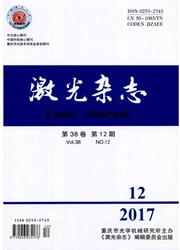

 中文摘要:
中文摘要:
利用积分时间分辨荧光光谱方法,研究了RbH(X1Σ+,v=0~2)与H2间的振动碰撞能量转移。在Rb-H2混合样品池中,泵浦激光双光子激发Rb原子至6D态,Rb(6D)与H2反应生成RbH(X1Σ+)分子,探测激光延迟泵浦激光20ns,通过激光感应荧光光谱(LIF)的测量,确定了X1Σ+(v=0~2,J)原生态的转动布居分布。增加检测激光与泵浦激光的延迟时间,测量了0~10μs延迟时间内各振动态时间分辨LIF强度,v=0,1能级荧光信号先增加后缓慢减弱,这是因为RbH在瞬间形成后通过碰撞转移和扩散而减少所致。通过速率方程分析,并利用振动能级上布居数变化与积分时间分辨荧光强度的关系,得到v=1→v=0和v=2→v=1的碰撞转移速率系数分别为(2.8±0.6)×10-11cm3·s-1和(3.4±0.8)×10-11cm3·s-1。而v=0,1,2的扩散率分别为(4.9±1.1)×105,(1.0±0.3)×105,(0.6±0.2)×105s-1。实验表明,v=2能级上布居数衰减率最大。
 英文摘要:
英文摘要:
The vibrational energy transfer from vibrational levels of RbH(X 1Σ+,v=0~2) by collision with H2 was determined using the integrated time-resolved laser induced fluorescence(LIF) in a five-arm crossed heat-pipe oven.Rb-H2 mixture was irradiated with pulses of 696.4 nm radiation from a OPO laser,populating 6D state by two-photon absorption.The vibrational levels of RbH(X 1Σ+) generated in the reaction of Rb(6D) and H2 were detected by LIF technique.The nascent quantum state distributions of RbH were obtained when the delay time between the pump and probe laser was 20 ns.The nascent RbH product molecules were found to populate the lowest three vibrational(v=0,1,2) levels of the ground electronic state but could not be detected in any higher vibrational state.The integrated time-resolved LIF excited A 1Σ+→X 1Σ+ system in the presence of H2 was recorded with delay time from 0 to 10 μs.The RbH signal of v=0,1 levels first increased and then decreased on a larger time scale.RbH was created instantaneously then was quenched by collision and diffused.The rate equations for the population of the vibrational levels were given.The integrated profiles method permitted us to determine the rate coefficients for vibrational transfer of RbH(X 1Σ+,v=0~2) by collision with H2.The rate coefficients for collisional transfer of RbH(X 1Σ+) by collisions with H2 are(in units of 10-11 cm3·s-1) 3.4±0.8 and 2.8±0.6 for v=2→v=1 and v=1→v=0 respectively.The diffusion rates of v=0,1,2 are(in units of 105 s-1) 4.9±1.1,1.0±0.3a nd 0.6±0.2,respectively.The experiment showed that vibrational relaxation from RbH(X 1Σ+,v=0~2) was more efficient compared to that of other vibrational levels studied here.
 同期刊论文项目
同期刊论文项目
 同项目期刊论文
同项目期刊论文
 Rotational and vibrational state distributions of CsH and relative reactivity in reactions of Cs(62D
Rotational and vibrational state distributions of CsH and relative reactivity in reactions of Cs(62D Measurement of the 87Rb[5P3/2(F`=3)-5S1/2(F=2)] effective nonradiative relaxation rate near a metall
Measurement of the 87Rb[5P3/2(F`=3)-5S1/2(F=2)] effective nonradiative relaxation rate near a metall 期刊信息
期刊信息
